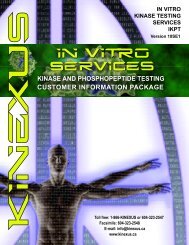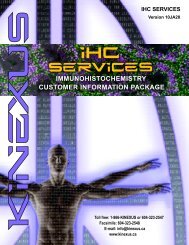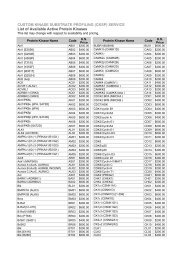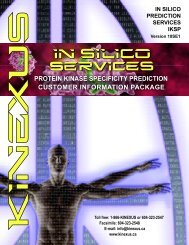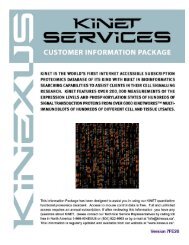see our Competitor Analysis - Kinexus Bioinformatics Corporation
see our Competitor Analysis - Kinexus Bioinformatics Corporation
see our Competitor Analysis - Kinexus Bioinformatics Corporation
Create successful ePaper yourself
Turn your PDF publications into a flip-book with our unique Google optimized e-Paper software.
Appendix B<br />
High Content Antibody Microarray <strong>Competitor</strong> <strong>Analysis</strong><br />
Performed in-house by <strong>Kinexus</strong> <strong>Bioinformatics</strong> <strong>Corporation</strong><br />
Date: 2015 February 15<br />
Company <strong>Kinexus</strong> Full Moon Hypromatrix<br />
Array name<br />
KAM-880 Antibody<br />
Microarray<br />
Phospho Explorer Antibody<br />
Microarray<br />
Signal Transduction<br />
AntibodyArrayTM<br />
Catalogue ID KABM-KAM880 PEX100 HM3000<br />
Total number of distinct antibodies (1,2) 877 1318 399<br />
Non-redundant - Pan antibodies (3) 374 354 395<br />
Non-redundant Phospho antibodies (4) 283 283 2<br />
Redundant - Pan antibodies 192 380 2<br />
Redundant Phospho antibodies 28 301 0<br />
Total number of antibody spots<br />
and configuration per kit (5,6)<br />
1 x 877 x 2 x 2 =<br />
3,508<br />
2 x 1318 x 2 =<br />
5,272<br />
1 x 399 x 1 =<br />
399<br />
Median range in duplicates from average (7,8) 9% 4% NA<br />
Dynamic range (9) >6000-fold 1250-fold NA<br />
Array type<br />
3D matrix coated glass slide 3D polymer coated glass Nitrocellulose membrane<br />
slide<br />
Recommended or provided detection (6)<br />
Non-competitive/ Single Non-competitive/ Single Non-competitive/ Antibody<br />
dye<br />
dye<br />
Kit price - chip/array + reagents (10) $749 1,380 + 320 + 50 = $1,750 980 + 200 = $1,180<br />
Kit price per antibody spot 21¢ 33¢ 295¢<br />
Service price - chip/array report generation (11, 12) $249 No No<br />
Citations via Google Scholar (13) 147 85 40<br />
Antibody microarray database access (14) Yes No No<br />
Follow-up Western blotting service (15) Yes No No<br />
Case Study: Samonella infected HeLa cells (16)<br />
% of antibodies showing<br />
≥50% changes from<br />
untreated control:<br />
224/803=27.9%<br />
% of antibodies showing<br />
≥50% changes from<br />
untreated control:<br />
6/1318=0.5%<br />
NA<br />
Notes<br />
1.<br />
2. The KAM-880 chip features 65 pan-specific and 4 phosphosite-specific antibodies for protein phosphatases.<br />
3. Non-redundant antibodies refers to those that target a particular protein or phosphosite. Redundant antibodies correspond to additional antibodies<br />
that target a protein for which a non-redundant antibody is already provided, but a different epitope in that protein may be selected. Pan-specific<br />
antibodies recognize the target proteins whether they are phosphorylated or not, except in the case of the Phospho Explorer Antibody Microarray<br />
from Full Moon. In this case, their pan-specific antibodies recognize only the dephosphorylated forms of the target proteins on their microarray.<br />
Consequently, these antibodies do not provide an accurate measure of the changes in total target protein levels due to expression changes.<br />
4. Phospho-antibodies recognize distinct phosphorylation site sequences when they are phosphorylated. For some arrays, generic phospho-tyrosine,<br />
phospho-threonine and/or phospho-serine antibodies may also be included.<br />
5. The first number refers to the number of glass slides or membranes provided for the price shown.<br />
6. Number of distinct fields per slide. In a non-competitive, single dye-binding application, 1 sample would be analyzed per field. In a competitive, two<br />
dye-binding application, 2 samples would be analyzed per field. However, due to differential dye binding by proteins, it is necessary to perform<br />
another microarray analysis with identical samples and protocols, except the dyes are switched between the samples. The competitive, two dyebinding<br />
methodology is not recommended due to this problem and because of poorer dynamic range. Number of spots includes duplicates.<br />
7.<br />
8.<br />
9.<br />
10.<br />
The KAM-880 chip features 307 pan-specific and 200 phosphosite-specific antibodies for protein kinases.<br />
NA = Not available or not applicable<br />
Median error range is estimated from the difference of duplicate antibody spot measurements with the average of recorded signals from these spots.<br />
The percent error is generally reduced with stronger detected antibody spot signals.<br />
Dynamic range is based on the highest and lowest detected signals that have percent errors within 20% of the recorded spot signal strength<br />
The first number for the Full Moon and Hypromatrix kits refers to just the U.S.purchase of only arrays without the support reagents that come<br />
standard with the KAM-880 kit. For the Full Moon microarray kits, supporting reagents must be purchased separately for an additional $320, but this<br />
does not include the cost of the dye for labeling proteins. We have added another $50 to cover this. For the Hypromatrix membranes, no supporting<br />
reagents are included, so we have conservatively added another $200 to cover the detection reagents. The extra shiping costs for additional<br />
supporting reagents from other supplier is not included.<br />
11. Clients can send processed microarray chips to <strong>Kinexus</strong> for generation of a Report that includes data analyses and identification of leads for followup.<br />
The KAM-880 Report also includes Kinections Pathway <strong>Analysis</strong> with over 60 graphic maps that are directly linked to the client's results.<br />
12. Clients can send cell/tissue lysate samples to <strong>Kinexus</strong> and Full Moon for antibody microarray analyses as a service. <strong>Kinexus</strong> offers non-confidential*<br />
and fully confidential** pricing options. Non-confidential results may be placed in the open-access KiNET website after a 6 month hold.
Notes<br />
13.<br />
14.<br />
15.<br />
16.<br />
Summary<br />
Based on searches with Google Scholar that includes the name of the company and the specific kit. This approach may not capture all literature<br />
references, but it provides equitable search parameters. Over one hundred and fifty literature references to the Kinex antibody microarrays can be<br />
generated with broader search terms.<br />
<strong>Kinexus</strong> provides open-access to its online KiNET Antibody Microarray database with the results from over 2000 different Kinex KAM analyses as<br />
well as Kinetworks multi-immunoblotting data from over 6000 other cell/tissue lysate samples from its KiNET Immunoblotting database.<br />
<strong>Kinexus</strong> provides a custom multi-immunoblotting service in which 18 different leads from the Kinex KAM-850 Antibody Microarray can be confirmed<br />
by Western blotting for $650. per sample with a 2-3 week turn-around.<br />
About 19% of the phosphosite- and 18% of the pan-specific antibody targets on the Full lMoon microarray are similarly tracked with the Kinex<br />
microarray. For this study, the Kinex KAM-800 Antibody Microarray chip was originally used. In a parallel study with similar cell lysates, Samonella<br />
was observed to induce significant changes in 24% of 9508 different phosphosites in 1973 HeLa cell proteins (Lindsay et al. (2011) Science Signaling<br />
4 (191), rs9. [DOI:10.1126/sciscignal.2001668]).<br />
This competitor analysis clearly demonstrates that the Kinex KAM-880 Antibody Microarray is superior to all of its competitors with respect to:<br />
• largest coverage of diverse non-redundant target proteins and phosphosites:<br />
• largest total number of protein kinase and protein phosphatases targets;<br />
• minimization of overlap of epitopes to permit highest pairing of phosphosite- and pan-specific antibodies;<br />
• improved analyses with novel chemical cleavage of lysate proteins, non-competitive, single dye methodology, and usage of same chip for two<br />
separatecell/tissue lysate samples;<br />
• greatest dynamic range of detection;<br />
• lowest pricing per antibody spot regardless of whether clients purchase only the KAM-850 chip, the kit or utlize <strong>our</strong> convenient proteomics services;<br />
• greatest validation in the scientific literature from the most published scientific reports using the Kinex antibody microarrays;<br />
• online, open-access to the results of thousands of other studies using the Kinex antibody microarrays; and<br />
• the ability to have lead results from the KAM-880 chips confirmed for clients with a convenient and economical Western blotting service.<br />
It is unclear where the antibodies printed on the arrays of <strong>our</strong> competitors are s<strong>our</strong>ced from, and in some cases, they state that they will not reveal<br />
this. However, <strong>our</strong> antibodies have been cherry-picked from over 25 different vendors, and selected from the top 25% of all of the more than 6000<br />
antibodies independently and stringently tested by <strong>Kinexus</strong>. Moreover, about a quarter of the antibodies used in the KAM-880 chip were developed inhouse<br />
at <strong>Kinexus</strong> and are rigorously tested and available in 25 µg amounts for less than US$90. We are pleased to disclose the commercial s<strong>our</strong>ces<br />
of antibodies that prove to be interesting and useful to <strong>our</strong> clients. We are happy to assist <strong>our</strong> clients in planning their studies and helping to interpret<br />
their results with <strong>our</strong> friendly and knowledgeable service representatives. Over 1700 scientists in over 35 countries world-wide have benefited from<br />
<strong>our</strong> powerful suite of proteomics and bioinformatics services. You can <strong>see</strong> more for less from <strong>Kinexus</strong> than from any of <strong>our</strong> competitors, and we have<br />
lots of data to prove it.<br />
Website<br />
www.kinexus.ca




